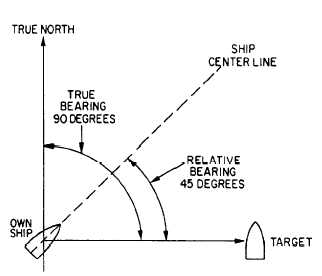Bearing
Radar bearing is determined by the echo signal
strength as the radiated energy lobe moves past the
target. Since search radar antennas move continuously,
the point of maximum echo return is determined either
by the detection circuitry as the beam passes the target
or visually by the operator.
Weapons control and
guidance radar systems are positioned to the point of
maximum signal return and maintained at that position
either manually or by automatic tracking circuits.
TRUE BEARING.— The angle between true north
and a line pointed directly at a target is called the true
bearing (referenced to true north) of a radar target. This
angle is measured in the horizontal plane and in a
clockwise direction from true north.
RELATIVE BEARING.— The angle between the
centerline of your own ship or aircraft and a line pointed
directly at a target is called the relative bearing of the
radar target. This angle is measured in a clockwise
direction from the centerline.
Both true and relative bearing angles are illustrated
in figure 1-2.
Most surface search radars will provide only range
and bearing information. If the operator had a need to
direct air traffic or to track incoming missiles, the radar
would also have to provide altitude.
Altitude
An operator can determine the altitude of a target by
adjusting a movable height line on a height indicator to
Figure 1-2.—True and relative bearings.
the point where it bisects the center of the target. The
altitude is then displayed by an altitude dial or digital
readout. A search radar system that detects altitude as
well as range and bearing is called a three-dimensional
(3D) radar.
Altitude or height-finding radars use a very narrow
beam in the vertical plane. This beam is scanned in
elevation, either mechanically or electronically, to
pinpoint targets. Tracking and weapons-control radar
systems commonly use mechanical elevation scanning
techniques. This requires moving the antenna or
radiation source mechanically. Most air search radars
use electronic elevation scanning techniques. Some
older air search radar systems use a mechanical
elevation scanning device; however, these are being
replaced by electronically-scanned radar systems.
RADAR DETECTING METHODS
Radar systems are normally divided into
operational categories based on energy transmission
methods. Although the pulse methcd is the most
common method of transmitting radar energy, two other
methods are sometimes used in special applications.
These are the continuous wave (cw) method and the
frequency modulation (fm) method.
Continuous Wave
The continuous wave (cw) method uses the Doppler
effect to detect the presence and speed of an object
moving toward or away from the radar. The system is
unable to determine the range of the object or to
differentiate between objects that lie in the same
direction and are traveling at the same speed. It is
usually used by fire control systems to track fast moving
targets at close range.
Frequency Modulation
With the frequency modulation (fm) method,
energy is transmitted as radio frequency (rf) waves that
continuously vary, increasing and decreasing, from a
fixed reference frequency. Measuring the difference
between the frequency of the returned signal and the
frequency of the radiated signal will give an indication
of range. This system works well with stationary or
slowly-moving targets, but it is not satisfactory for
locating moving objects. It is used in aircraft altimeters
that give a continuous reading of how high the aircraft
is above the earth.
1-3


